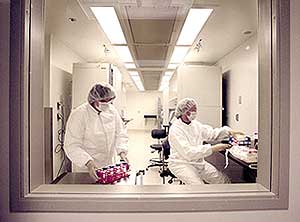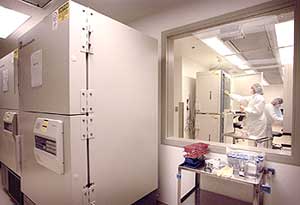 |
|||||||||
|
Research Feature Stories: Other News: |
Genomics Advances Spur Gene Therapy Studies
Already Active Program Seizes New Opportunities
The UW’s leadership in human genome sequencing technology and mapping has spawned new opportunities for its already active programs in gene therapy and blood stem cell biology. Genomics has opened the door for gene therapy, according to Dr. George Stamatoyannopoulos, professor of medicine, head of the Division of Medical Genetics and director of the Markey Molecular Medicine Center.
Stamatoyannopoulos said the field is still in its infancy. The first clinical trials were performed little more than a decade ago, and the therapeutic potential has been barely tapped. Some of the most prominent targets for gene therapy are blood diseases, such as sickle cell anemia, beta thalassemia, adenosine deaminase deficiency, and cancers. However, researchers are also investigating gene transfer into other tissues to treat patients with damaged hearts, Alzheimer’s, and liver disease, for example.
 |
An inside look through a protective glass window at gowned, gloved and masked researchers in the Gene and Cell Therapy Core Laboratory, a setting to test new treatment strategies. |
Studies pioneered in part by researchers at the UW and Fred Hutchinson Cancer Research Center indicate that transplantation of hematopoietic (blood-forming) stem cells can be used to treat patients with aggressive forms of blood cell cancers. One study compared patients who received stem cells collected from bone marrow against those who received stem cells collected from peripheral blood of related donors. Some 65 percent of the patients who received the peripheral blood stem cells remained disease-free after two years, compared to 45 percent for recipients of more conventional bone marrow transplants. Patients with advanced malignancies appeared to benefit the most from the peripheral blood stem cell therapy.
UW researchers see great potential in the use of hematopoietic stem cells. Dr. David Emery, research assistant professor of medicine, said several recent publications indicate that it may be possible to make cells for the liver, muscles and possibly the brain from hematopoietic stem cells. Emery emphasized that these studies do not use embryonic stem cells, and that neither these cells nor the therapeutic genes introduced into the cells are passed on to subsequent generations. In this way, therapies based on these cells are conceptually no different from more conventional drug treatments.
|
The Gene and Cell Therapy Core Laboratory facility meets strict safety and purity standards for sophisticated procedures. |
 |
Adult stem cell research is moving forward on several fronts at the UW. A grant from the National Institute of Diabetes and Digestive and Kidney Diseases will enable researchers, with Stamatoyannopoulos as principal investigator, to study the molecular biology of blood stem cells and stem cell genes that play a key role in cell differentiation and proliferation. Investigators have already cloned and sequenced several thousand genes expressed in stem cells. The grant will enable researchers to develop strategies to analyze the genes’ functions. Related projects will examine genes affecting white blood cells and those implicated in some leukemias that run in families.
Another large program project grant supports the application of gene therapy in clinical trials. One study involves treating sickle cell anemia and beta thalassemia by introducing therapeutic genes into blood-forming stem cells and expressing these genes in red blood cells. In other studies, researchers are examining the prevention of graft-versus-host disease, which sometimes occurs in stem cell transplant recipients. There are also gene therapy trials for cystic fibrosis patients.
The UW is also committed to applying these new areas of research to actual clinical trials, and to that end has created a clinical Gene and Cell Therapy Core Laboratory. Housed at UW Medical Center’s General Clinical Research Center and funded in part by the National Center for Research Resources, this $3 million facility will enable gene and cell therapy researchers to move potentially therapeutic strategies from their labs into a clinical setting. One potential use, for example, involves removing immune system cells from HIV-positive patients, genetically modifying these cells to make them resistant to HIV infection, and growing the cells to expand cytotoxic T cells. These cells are infused back into the patients with the hope of improving their ability to fight the HIV infection.
Central to the function of this facility is the ability to manipulate patient tissue samples outside the body under extremely stringent standards of safety and purity demanded by the current Good Manufacturing Practice regulations.
|
| UW AMC Medical Center | UW School of Medicine | Harborview | UW MC | Search UW AMC | UW Home | Contact Us | ©2001-2002, University of Washington Academic Medical Center. All rights reserved. Please honor our copyrights. |
|